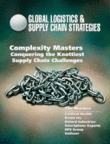
Visit Our Sponsors |
|
|
|
|
|
|
|
|
|
|
|
|
|
|
|
|
|
|
|
|
|
|
|
|
|
|
|
|
|
|
|
|
|
|
|
|
|
|
|
|

The biggest global companies have a reputation for asserting control over every part of their operations, and Unilever is no exception. With revenues of more than $53bn in fiscal 2007, the giant seller of some 400 name brands in food and personal care calls the shots throughout much of its sprawling supply chain. Until recently, however, Unilever hadn't given much attention to one key aspect of its operations: the inbound side.
Acquisitions and a corporate restructuring prompted Unilever to take another look. The company had decided to merge several key units-food and beverage, home and personal care, and ice cream-into one operating framework in the U.S., according to director of logistics Mary Lane. (Household names that are part of Unilever include Best Foods, Imperial Margarine, Lipton Ice Tea, Ragu Pasta Sauce, Skippy Peanut Butter and Wish-Bone Salad Dressing.) One of the outgrowths of that program was a bid to take control over inbound, consisting mostly of raw materials and packaging, and make maximum use of carrier capacity. Says Lane: "We needed to get to one way of working."
Each operating unit had developed its own way of handling logistics. The job of booking carriers and moving inbound freight was largely left up to vendors, and the company had little visibility over that process.
"We would provide them with routing guides, but at the end of the day we had no way of holding them accountable to it," says Lane. Unilever simply didn't know whether vendors were utilizing the best modes in terms of cost and efficiency. In many cases, the cost of freight wasn't being broken out from the price of the goods, so the company couldn't fully assess vendor compliance even at the point of payment.
At the same time, Unilever was saddled with different supply chain planning and execution software in the foods group and in health and beauty care. It needed a common technology platform that could more easily integrate with its SAP enterprise resource planning backbone. The goal was to centralize transportation planning and procurement, while achieving visibility of all movements across the supply chain.
The decision to merge multiple systems into one gave Unilever the impetus to take a fresh approach to inbound. One option was to do it all in-house, but the company instead sought a technology partner to handle the process-management side on an outsourced basis. "This work had not been done internally before, and from a cost and complexity standpoint it wasn't something we wanted to bring in house," says Lane.
Unilever had been a customer of Holland, Mich.-based LeanLogistics since 2004, using that tech vendor's On-Demand TMS for outbound movements in the foods division. Two years later, the health and personal care division adopted the LeanLogistics tool for its own use on the outbound side. Then, in 2008, Unilever decided to begin directly managing inbound refrigerated and dry movements to all of its divisions.
The idea was hatched by the refrigerated component of the foods division, "where freight optimization was key in managing our costs," says Lane. Much of that business was moving via less-than-truckload carriers, and Unilever thought it could save money by converting at least some of the volumes to more cost-efficient truckload.
In vowing to get a tighter grip on inbound, Unilever was following a recent trend among global companies. "In the last three to five years, more manufacturers have been taking a look at inbound," says Chris Timmer, vice president of sales and marketing with LeanLogistics. Rising rates and fuel costs have increased the pressure on those organizations to squeeze more efficiencies out of the logistics process, he adds. The need for increased visibility in times of economic uncertainty and rising customer demands are two more reasons why companies are no longer willing to trust vendors with that crucial link in the supply chain.
The Hosted Approach
LeanLogistics was the natural candidate for extending its capability into Unilever's inbound operations in the U.S. The vendor offers its applications through a hosted, or software-as-a-service (SaaS) model, an approach "that has been built into our culture for four or five years," says Lane. That includes the TMS packages from LeanLogistics that Unilever had been using in its various divisions.
Unilever opted for the LeanLogistics offering known as Managed Transportation Services, which combines the On-Demand TMS package with transportation planning, execution and settlement. In essence, LeanLogistics' software and staff manage Unilever's entire U.S. inbound program. "We do everything a 3PL would do - measurement, metrics, management, making sure that carriers are picking up and delivering, and making the right load plans," says Timmer.
What LeanLogistics doesn't do is own the contracts with carriers. That responsibility is left to Unilever, which handles actual carrier procurement, supported by analytics and processes within On-Demand TMS. It pays the vendor according to the number of shipments processed, not the size of its annual freight bill.
Unilever began the program with its ice cream business, consisting of the Ben & Jerry's and Breyers brands. (The company bought Breyers in 1993, and Ben & Jerry's in 2000.) It was already in the process of applying On-Demand TMS to that operation for outbound moves, Lane says, and didn't want to go through a major IT change twice. Food and personal care were to follow by February of this year, going beyond a stand-alone software application to include "3PL-type activities," according to Lane.
Unilever wasn't worried about letting an outsider like LeanLogistics run its entire freight network. "I don't think that companies need to be afraid of outsourcing," says Lane. "They [LeanLogistics] clearly understand software and how to utilize it, and they have a team that is dedicated to Unilever. Those folks eat, live and breathe Unilever as much as my own people do."
In any case, Unilever doesn't farm out the job of dealing directly with its carriers. "The customer is retaining all of the control," says Lisa Kerr, director of managed services with LeanLogistics. "We execute the plan that the customer has laid out. And we bring to them suggestions for continuous improvement."
Because of its sheer size, Unilever poses a significant challenge to any service provider. There are hundreds of vendors in the inbound network, notes Kerr, ranging across the categories of reefer, dry, intermodal, LTL and airfreight. Further complications arise from Unilever's need to build multi-stop pickup runs on the inbound side, to squeeze the most efficiency out of its refrigerated carrier base. Routing often calls for the movement of consolidated loads for multiple divisions of the company. At the same time, the setup requires a centralized command structure so that Unilever can optimize the entire system.
In fact, Kerr says, the degree of complexity in Unilever's supply chain wasn't fully evident until the company got a look at what goes on in the inbound operation. Previously, it didn't know what kind of practices vendors were employing to meet delivery dates, or how inconsistent lead times tended to be, based on a given route, mode or carrier.
Achieving Visibility
Shipment visibility today comes from a wealth of data flowing through the system from carriers and other vendors. Unilever's buyers and plant operations now have a much better idea of what's on the way, and which shipments are ready to be picked up, says Timmer. The technology provides alerts when anomalies occur, with multiple management dashboards enabling Unilever to be proactive in the event of a glitch that might have an impact on product availability.
Performance metrics are set from the beginning, covering such elements as on-time delivery and tender acceptance by carriers. In the process, Unilever can control daily usage of carrier capacity, ensure conformity with contracts and routing guides, and eliminate "rogue" spending.
"We work with the client to determine what will be captured in the scorecard," says Kerr. "At any time, our carriers can go and check their on-time performance." The centralized platform can be tweaked to meet the specific needs of each client, Timmer adds.
Unilever is still in the early stages of the inbound program, having gone live last October. Since that time, says Lane, "all of our KPIs [key performance indicators] have been met." The company can go online at any time to monitor the progress of the operation. In addition, appropriate managers get daily feedback, allowing for continuous tracking of both cost and service levels.
For the moment, the program remains limited to North America, although Lane remains open to the possibility of applying it to Unilever's international operations. Canada in particular "is a distinct possibility," she says.
Once the inbound is fully under control, Unilever might consider moving the application into other parts of its business. "LeanLogistics does a good job of taking multiple small shipments and building full truckloads," says Lane. And most of Unilever's customers order in truckload quantities. So the company is looking to reduce its expenditures on LTL and parcel shipments in other areas as well.
Timmer says LeanLogistics would like to help Unilever on the outbound side, over which the customer asserts more direct control. "There have been discussions about that," he says. But the fact that all inbound and outbound shipments already move through the same technology platform means that Unilever has many opportunities to optimize transportation under the system in its current form.
For its part, LeanLogistics is looking to capitalize on its acquisition last year by Brambles, the parent company of pallet and container pooling company CHEP. LeanLogistics currently resides under the CHEP umbrella, and Timmer believes the relationship could help to propel the company into deeper areas of logistics services, including yard management and a Google-like carrier database. The latter would allow LeanLogistics to offer customers a self-service model for carrier services, rather than deploying an entire TMS.
Unilever seems content with the extended functionality of the LeanLogistics platform and managed-services offering. "It's optimizing our freight spend and reducing our complexity without draining our internal resources," says Timmer. "It's a cost-effective opportunity."
RESOURCE LINK:
LeanLogistics, www.leanlogistics.com
RELATED CONTENT
RELATED VIDEOS
Timely, incisive articles delivered directly to your inbox.






